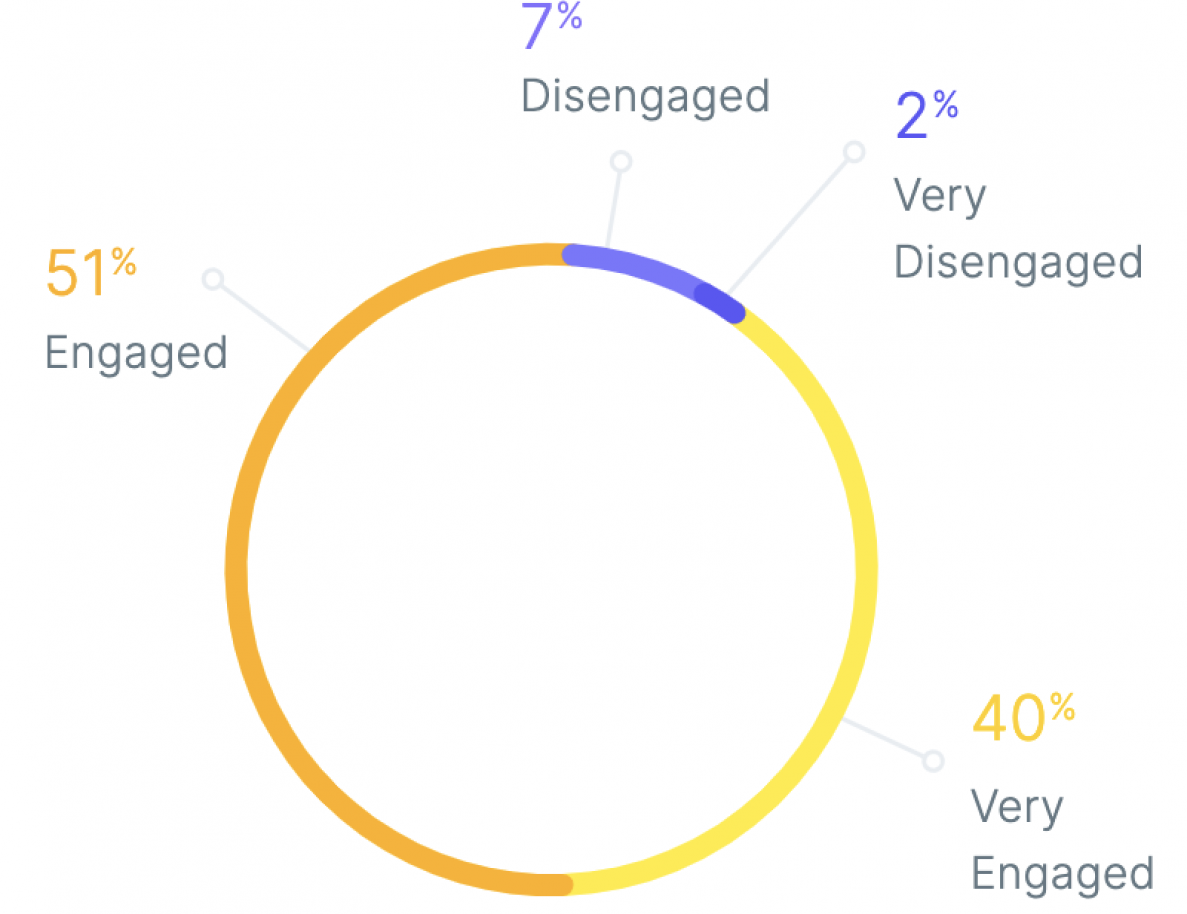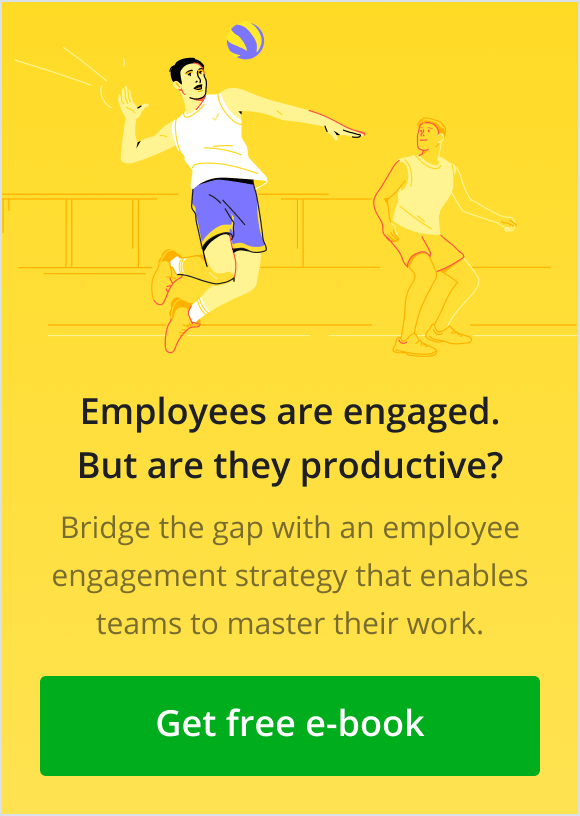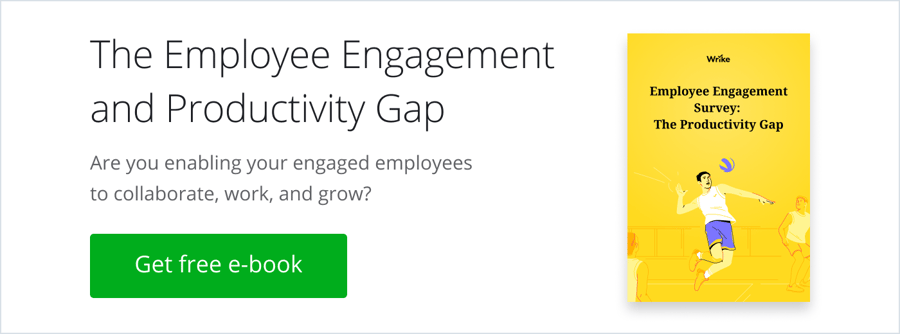Key takeaways:
- What is the relationship between employee engagement and productivity? Engaged employees show commitment to organizational goals, but may not always be productive due to administrative burdens.
- How can companies increase profitability? A 10% increase in employee engagement can boost profits by $2,400 per employee annually.
- What tools can enhance employee engagement? Access to work from anywhere, automation of repetitive tasks, and clear workload visibility are key tools.
- How prevalent is disengagement among workers? Despite high engagement rates, nearly half reported being productive less than 75% of the time.
- What factors contribute to disengagement? Feeling undervalued, burnt out, or unrecognized can lead to disengagement among employees.
Employee engagement is a hot topic for business leaders around the globe — and for good reason. Studies show that companies with engaged employees realize greater productivity and higher profits than those with less-engaged workers. For example:
- Teams with high employee engagement have better customer engagement, greater productivity, better retention, and 21% higher profitability. (Source: Gallup)
- A 10% increase in employee engagement investments can increase profits by $2,400 per employee per year. (Source: Palmer Morrel-Samuels at Workplace Research Foundation)
- Companies with engaged employees outperform those without by 202%. (Source: Dale Carnegie)
Despite the fact that studies have shown the connection between employee engagement and profits, many leaders still don’t know how to strategically bridge the gap. In fact, one study from Dale Carnegie reveals that only about 25% of business leaders have an employee engagement strategy.
Profits, productivity, and your business are on the line, so our team at Wrike did an online survey of 5,000+ adults in the United States, United Kingdom, France, Germany, and Australia, who work full-time for an organization with 500+ employees.
Throughout the survey, we uncovered a deeper connection between employee engagement and productivity. Read our full survey report to discover what drives employee engagement across job level, geography, gender, personality, company size, and more so you can build an engagement strategy that grows your business.
Employees are engaged, but are they productive?
Employee engagement is not the same as happiness or satisfaction. Engagement is the personal commitment an employee has to their organization’s goals and overall success. It’s the amount of passion they have for their work and their willingness to put forth effort. So...
We started our survey with the most important question.
How engaged are you at your current company?

At first, we were shocked to discover that 91% of our global sample reported that they were engaged at work, particularly when Gallup’s 2018 survey of employee engagement reported a rate of 34% engagement. However, they also reported that 13% of employees felt disengaged, which is in the ballpark of our 9% figure. But it’s important to note that in our survey, 65% of respondents were in leadership positions, and research has shown that managers tend to be more engaged than individual contributors.
Our survey reflected this — 13% of individual contributors reported being disengaged, compared to 5% of managers and 3% of executive respondents.

In our survey, our respondents said they are engaged when they enjoy their work, collaborate well, and understand how their work contributes to overall company goals. They become disengaged when they feel unrecognized or undervalued, feel underpaid, and are burnt out.
When employees are disengaged, they say that their productivity suffers or they do less work than usual, they care less about the quality of their work, and they vent to their colleagues.
Not only does a disengaged employee affect their own productivity, but they impact the productivity and engagement of those around them — poisoning the work culture for everyone. One study showed that disengaged employees cost organizations between $450 and $550 billion annually, while highly engaged business units result in 21% greater profitability. When disengagement spreads, numbers like that can make or break your business.
The productivity gap
Despite the 91% of our respondents who felt engaged, almost half of those surveyed (48%) said they were productive less than 75% of the time. Disengaged employees were even less productive and were 80% more likely to say they were productive less than 75% of the time. That’s a quarter of employee work time that could be better utilized.
| Figure 7: On average, what percentage of the time are you motivated and productive at work? | |
| Less than 10% | 2% |
| 11-24% of the time | 3% |
| 25-49% of the time | 13% |
| 50-74% of the time | 30% |
| 75-89% of the time | 34% |
| 90% of the time or more | 18% |
But since our survey respondents did say they were so engaged, there is clearly a complicated relationship between engagement and productivity.
Instead, consider this scenario. You’re an engaged employee. You come to work, get involved with interoffice activities, believe in and enjoy your work, collaborate well with your colleagues and boss, and speak up in meetings. However, you’re still productive less than 75% of the time. Where is the disconnect?
One study found that employees wasted 21.8 hours per week looking for documents and project information. That’s 54.5% of a 40-hour workweek. And in Wrike’s professional services industry survey, 3 in 10 of those surveyed said they could achieve 30-39% more meaningful work if the repetitive, administrative parts of their job were automated.
The time spent sifting through emails, tracking down files, waiting on responses, trying to prioritize work, or even commuting is often to blame for the gap between employee engagement and productivity.
Engaged employees were 33% more likely than disengaged employees to say they had the tools, resources, and support needed to work effectively. This indicated a strong connection between enablement and happiness in the workplace. Could it be the secret to employee engagement and productivity is the tools you provide your employees?
The 5 top tools or capabilities to help teams become more engaged and productive at work?
- The ability to access my work at any time and work effectively from anywhere
- Automation for the repetitive or mundane parts of my job so I can focus on doing more impactful and strategic work
- A way for my manager to see everything on my plate and better balance my workload
- An easier and more effective way to collaborate in context across teams and stakeholders
- A better way to structure and view my/my team’s work so I can see how it supports larger company goals and initiatives
Your strategy to bridge the gap between engagement and productivity
1. Get mobile with your workforce.
It’s not surprising employees chose mobile access as the top capability to help them be engaged and productive. Over half (51%) of our survey respondents worked remotely to some degree. Mobile access also seemed to improve engagement. Employees who had the flexibility to work remotely were 73% more likely to say they were engaged. So it stands to reason that flexibility to work remotely helps improve employee engagement, but employees need tools to help them easily collaborate on projects while mobile.
Today’s workers are constantly collaborating across regions. As your company grows, you need a tool that can centralize project and work management so team members who aren’t colocated can work together seamlessly.
Every team member with access can immediately see the project’s history, conversations, tasks, and more. New team members and managers can hop right in and get all the information they need in one place instead of digging through disjointed email chains.
2. Bring in tools to automate administrative tasks and streamline workflows.
The most engaged employees enjoyed their work and understood how it impacted the overall company goals and success. On the flip side, 29% of disengaged workers felt burnt out.
In our professional service benchmark report, 3 in 10 respondents said they could achieve 30-39% more work if technology automated the repetitive, administrative parts of their job. About 1 in 5 (22%) said they could achieve 50% or more work.
A collaborative work management solution can automate manual project tasks so employees spend less time on tedious work and more time doing what they enjoy. Use it to automatically reschedule connected tasks, alert project members of status changes, automate project planning with templates, and so much more.
3. Unlock workload visibility.
Employees are a business’s most valuable resource. The top reason employees felt disengaged was because their work was undervalued or unrecognized, followed by burnout from being overworked.
A recent Gallup study found that 23% of employees reported feeling burned out at work very often or always. Between corporate fire drills, ad hoc requests, and unexpected project speed bumps, it’s challenging for managers to gain insight into their employees’ workloads and value the work their team is doing.
Collaborative work management tools provide improved visibility into team workload and utilization. For example, Wrike gives leaders a clear view of their team’s real-time workload. Intuitive capabilities like drag-and-drop rescheduling empower leaders to balance workloads. They can easily see who is overloaded and where work can be shifted to increase productivity. Meanwhile, reporting on project metrics helps them continue to refine and improve workload distribution.
4. Unify collaboration and communication onto one open platform.
In a survey from RingCentral on communication app overload in the workplace, 70% of workers said the volume of communication they receive is a top challenge. Workers toggle between apps up to 10 times per hour and, when they do, 31% report losing their train of thought. Between emails, IMs, hallway chats, and more, it can be hard to consolidate project information.
A collaborative work management tool keeps project information and communication in one place. Moving project conversations onto a platform where everyone (with permission) has the full context makes it easier for team members to locate work, make communication more transparent, and boost accountability.
5. Intake work that aligns with your team’s OKRs.
If your team is inundated with new tasks coming from all directions and is siloed between tools, they simply can’t complete projects at the speed your business requires. Move work intake requests from IMs, emails, and chats into one channel within your work management tool. Top-performing teams use request forms to consolidate incoming potential projects, funneling them right where their projects live.
Request forms are a type of project intake questionnaire that help a team get the project to the right place. By creating a clear path for new work, your team can easily prioritize work that aligns with overall company goals and stay in the zone.
Read the full survey report
Engagement and productivity are clearly connected, so it’s critical that your business takes steps to optimize engagement.
In our report, we dig into:
- Why employees are engaged
- Why employees are disengaged
- How enterprise companies’ challenges differ from SMB
- The gap between how individual contributors and managers are engaged or motivated
- How gender, generations, and geography impact engagement
- How introverts and extroverts want to be engaged
- A full strategy to move from connection engagement to productivity
Download the eBook below for the full picture!
Thanks for your interest in our eBook!
Download it nowWe have also sent the eBook link to your email for your convenience.




